Global Strategy Development and Implementation: KFC in Finland
VerifiedAdded on 2022/12/23
|13
|4172
|1
Report
AI Summary
This report provides a comprehensive analysis of KFC's global strategy for expansion into Finland. It begins with an introduction to global strategy and its relevance, followed by an examination of KFC's historical performance, product range, market share, and competitive position. The report then explores the reasons behind KFC's international expansion, specifically focusing on the Finnish market. It delves into possible strategic choices available to KFC, applying the Ansoff growth matrix to determine the most suitable approach. The report also discusses the strategic methods of entry, potential organizational and managerial problems, and provides strategic advice for the subsidiary to overcome these challenges. The report concludes with a summary of the key findings and recommendations for KFC's successful expansion into the Finnish market.
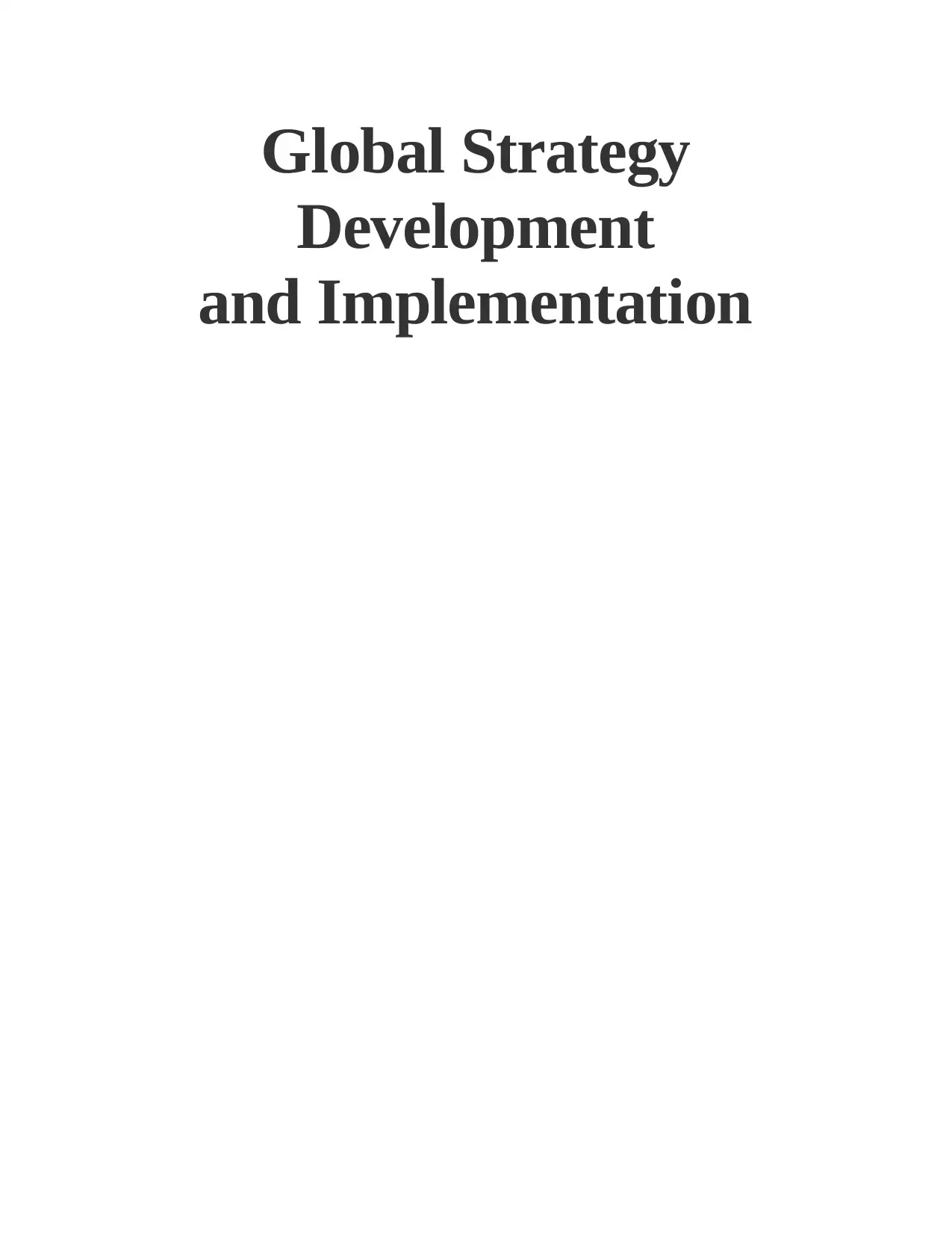
Global Strategy
Development
and Implementation
Development
and Implementation
Paraphrase This Document
Need a fresh take? Get an instant paraphrase of this document with our AI Paraphraser
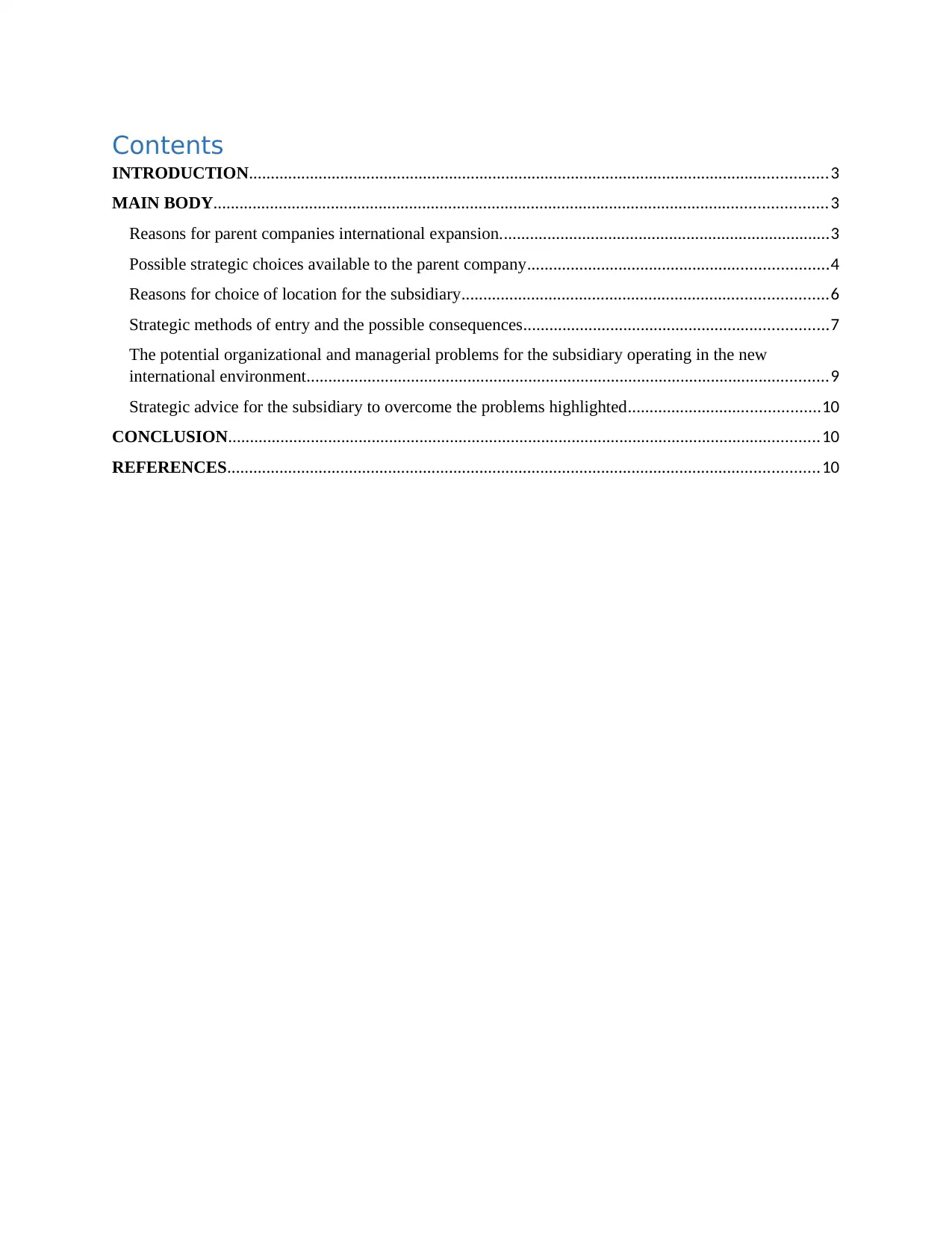
Contents
INTRODUCTION.....................................................................................................................................3
MAIN BODY.............................................................................................................................................3
Reasons for parent companies international expansion............................................................................3
Possible strategic choices available to the parent company.....................................................................4
Reasons for choice of location for the subsidiary....................................................................................6
Strategic methods of entry and the possible consequences......................................................................7
The potential organizational and managerial problems for the subsidiary operating in the new
international environment........................................................................................................................9
Strategic advice for the subsidiary to overcome the problems highlighted............................................10
CONCLUSION........................................................................................................................................10
REFERENCES........................................................................................................................................10
INTRODUCTION.....................................................................................................................................3
MAIN BODY.............................................................................................................................................3
Reasons for parent companies international expansion............................................................................3
Possible strategic choices available to the parent company.....................................................................4
Reasons for choice of location for the subsidiary....................................................................................6
Strategic methods of entry and the possible consequences......................................................................7
The potential organizational and managerial problems for the subsidiary operating in the new
international environment........................................................................................................................9
Strategic advice for the subsidiary to overcome the problems highlighted............................................10
CONCLUSION........................................................................................................................................10
REFERENCES........................................................................................................................................10
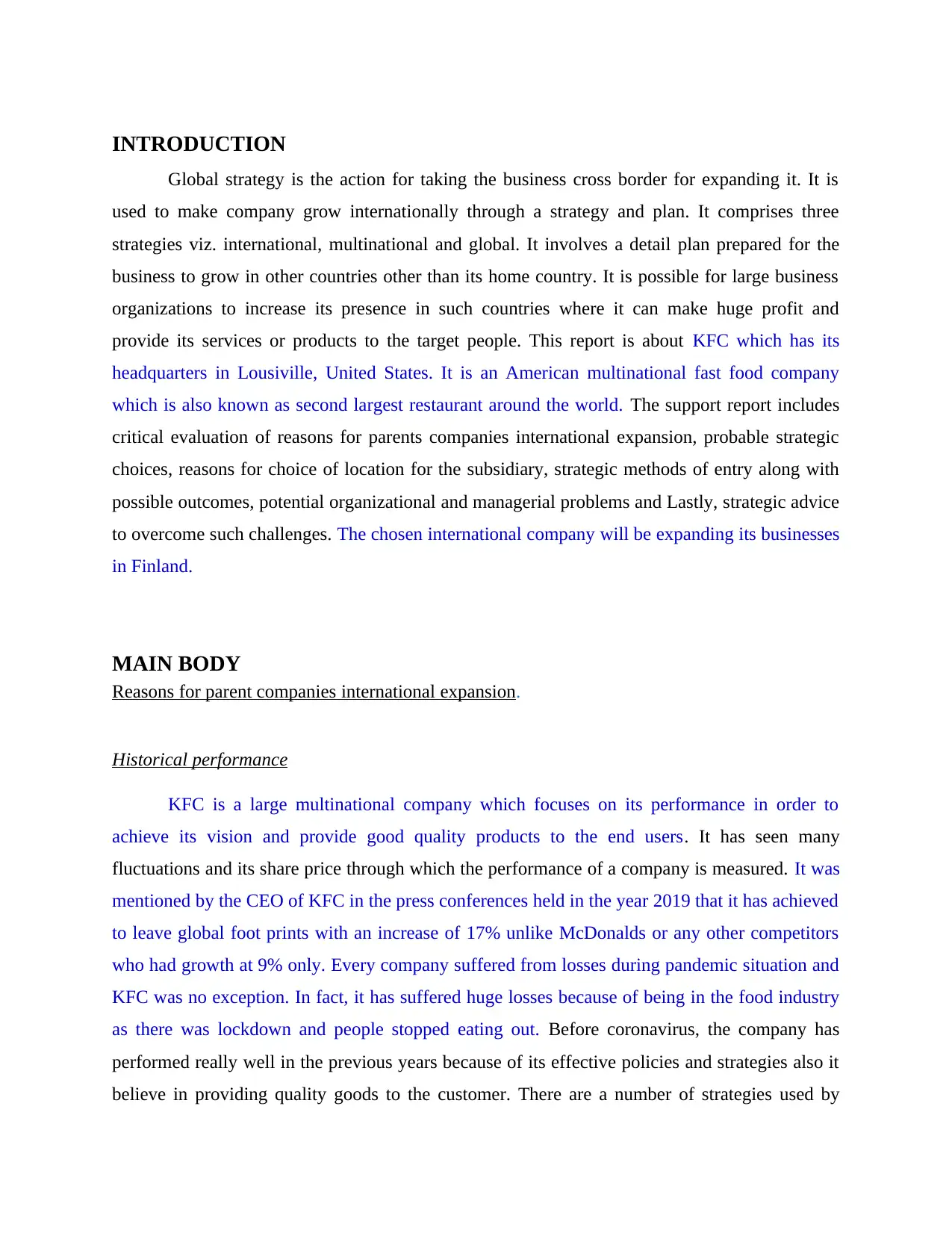
INTRODUCTION
Global strategy is the action for taking the business cross border for expanding it. It is
used to make company grow internationally through a strategy and plan. It comprises three
strategies viz. international, multinational and global. It involves a detail plan prepared for the
business to grow in other countries other than its home country. It is possible for large business
organizations to increase its presence in such countries where it can make huge profit and
provide its services or products to the target people. This report is about KFC which has its
headquarters in Lousiville, United States. It is an American multinational fast food company
which is also known as second largest restaurant around the world. The support report includes
critical evaluation of reasons for parents companies international expansion, probable strategic
choices, reasons for choice of location for the subsidiary, strategic methods of entry along with
possible outcomes, potential organizational and managerial problems and Lastly, strategic advice
to overcome such challenges. The chosen international company will be expanding its businesses
in Finland.
MAIN BODY
Reasons for parent companies international expansion.
Historical performance
KFC is a large multinational company which focuses on its performance in order to
achieve its vision and provide good quality products to the end users. It has seen many
fluctuations and its share price through which the performance of a company is measured. It was
mentioned by the CEO of KFC in the press conferences held in the year 2019 that it has achieved
to leave global foot prints with an increase of 17% unlike McDonalds or any other competitors
who had growth at 9% only. Every company suffered from losses during pandemic situation and
KFC was no exception. In fact, it has suffered huge losses because of being in the food industry
as there was lockdown and people stopped eating out. Before coronavirus, the company has
performed really well in the previous years because of its effective policies and strategies also it
believe in providing quality goods to the customer. There are a number of strategies used by
Global strategy is the action for taking the business cross border for expanding it. It is
used to make company grow internationally through a strategy and plan. It comprises three
strategies viz. international, multinational and global. It involves a detail plan prepared for the
business to grow in other countries other than its home country. It is possible for large business
organizations to increase its presence in such countries where it can make huge profit and
provide its services or products to the target people. This report is about KFC which has its
headquarters in Lousiville, United States. It is an American multinational fast food company
which is also known as second largest restaurant around the world. The support report includes
critical evaluation of reasons for parents companies international expansion, probable strategic
choices, reasons for choice of location for the subsidiary, strategic methods of entry along with
possible outcomes, potential organizational and managerial problems and Lastly, strategic advice
to overcome such challenges. The chosen international company will be expanding its businesses
in Finland.
MAIN BODY
Reasons for parent companies international expansion.
Historical performance
KFC is a large multinational company which focuses on its performance in order to
achieve its vision and provide good quality products to the end users. It has seen many
fluctuations and its share price through which the performance of a company is measured. It was
mentioned by the CEO of KFC in the press conferences held in the year 2019 that it has achieved
to leave global foot prints with an increase of 17% unlike McDonalds or any other competitors
who had growth at 9% only. Every company suffered from losses during pandemic situation and
KFC was no exception. In fact, it has suffered huge losses because of being in the food industry
as there was lockdown and people stopped eating out. Before coronavirus, the company has
performed really well in the previous years because of its effective policies and strategies also it
believe in providing quality goods to the customer. There are a number of strategies used by
⊘ This is a preview!⊘
Do you want full access?
Subscribe today to unlock all pages.

Trusted by 1+ million students worldwide
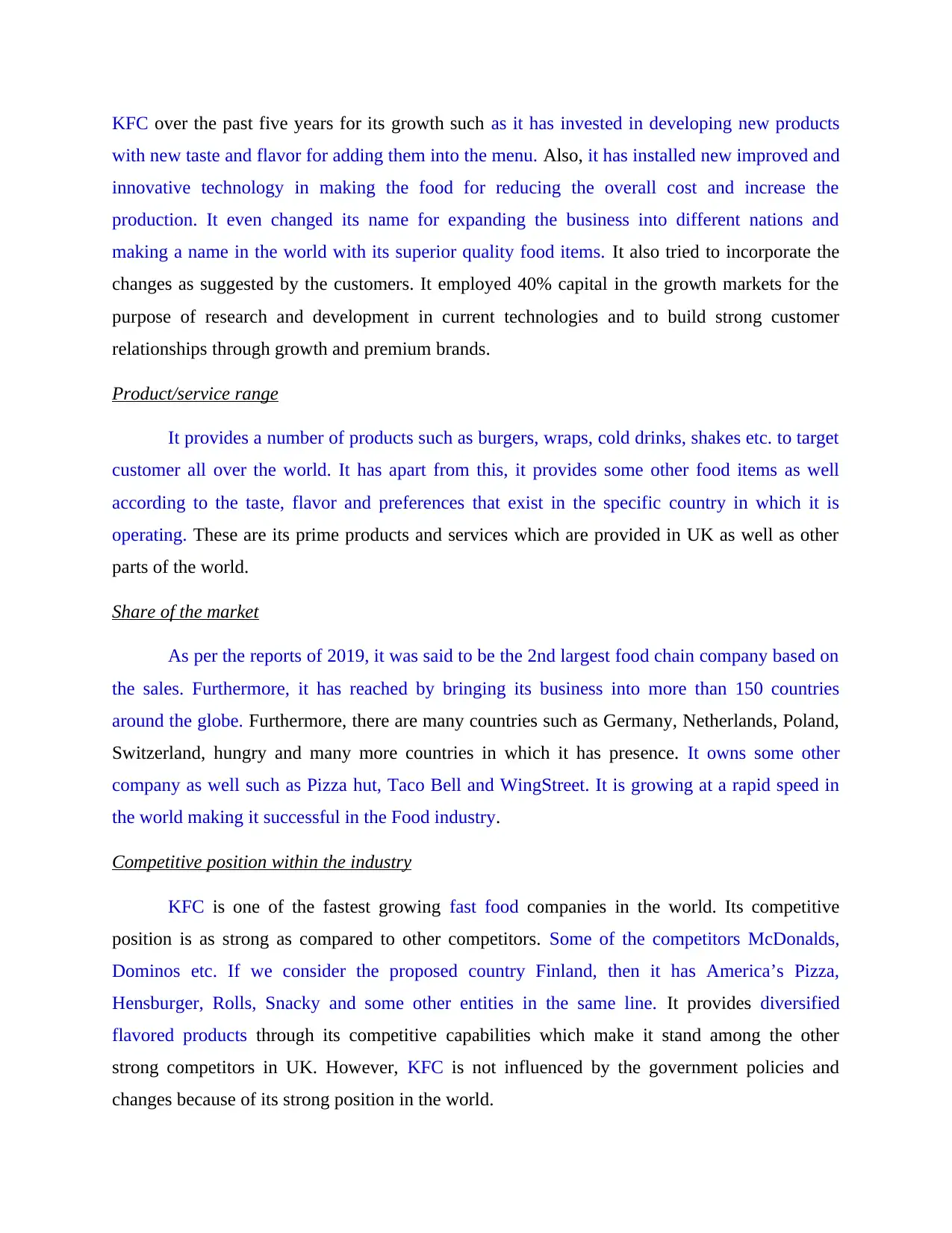
KFC over the past five years for its growth such as it has invested in developing new products
with new taste and flavor for adding them into the menu. Also, it has installed new improved and
innovative technology in making the food for reducing the overall cost and increase the
production. It even changed its name for expanding the business into different nations and
making a name in the world with its superior quality food items. It also tried to incorporate the
changes as suggested by the customers. It employed 40% capital in the growth markets for the
purpose of research and development in current technologies and to build strong customer
relationships through growth and premium brands.
Product/service range
It provides a number of products such as burgers, wraps, cold drinks, shakes etc. to target
customer all over the world. It has apart from this, it provides some other food items as well
according to the taste, flavor and preferences that exist in the specific country in which it is
operating. These are its prime products and services which are provided in UK as well as other
parts of the world.
Share of the market
As per the reports of 2019, it was said to be the 2nd largest food chain company based on
the sales. Furthermore, it has reached by bringing its business into more than 150 countries
around the globe. Furthermore, there are many countries such as Germany, Netherlands, Poland,
Switzerland, hungry and many more countries in which it has presence. It owns some other
company as well such as Pizza hut, Taco Bell and WingStreet. It is growing at a rapid speed in
the world making it successful in the Food industry.
Competitive position within the industry
KFC is one of the fastest growing fast food companies in the world. Its competitive
position is as strong as compared to other competitors. Some of the competitors McDonalds,
Dominos etc. If we consider the proposed country Finland, then it has America’s Pizza,
Hensburger, Rolls, Snacky and some other entities in the same line. It provides diversified
flavored products through its competitive capabilities which make it stand among the other
strong competitors in UK. However, KFC is not influenced by the government policies and
changes because of its strong position in the world.
with new taste and flavor for adding them into the menu. Also, it has installed new improved and
innovative technology in making the food for reducing the overall cost and increase the
production. It even changed its name for expanding the business into different nations and
making a name in the world with its superior quality food items. It also tried to incorporate the
changes as suggested by the customers. It employed 40% capital in the growth markets for the
purpose of research and development in current technologies and to build strong customer
relationships through growth and premium brands.
Product/service range
It provides a number of products such as burgers, wraps, cold drinks, shakes etc. to target
customer all over the world. It has apart from this, it provides some other food items as well
according to the taste, flavor and preferences that exist in the specific country in which it is
operating. These are its prime products and services which are provided in UK as well as other
parts of the world.
Share of the market
As per the reports of 2019, it was said to be the 2nd largest food chain company based on
the sales. Furthermore, it has reached by bringing its business into more than 150 countries
around the globe. Furthermore, there are many countries such as Germany, Netherlands, Poland,
Switzerland, hungry and many more countries in which it has presence. It owns some other
company as well such as Pizza hut, Taco Bell and WingStreet. It is growing at a rapid speed in
the world making it successful in the Food industry.
Competitive position within the industry
KFC is one of the fastest growing fast food companies in the world. Its competitive
position is as strong as compared to other competitors. Some of the competitors McDonalds,
Dominos etc. If we consider the proposed country Finland, then it has America’s Pizza,
Hensburger, Rolls, Snacky and some other entities in the same line. It provides diversified
flavored products through its competitive capabilities which make it stand among the other
strong competitors in UK. However, KFC is not influenced by the government policies and
changes because of its strong position in the world.
Paraphrase This Document
Need a fresh take? Get an instant paraphrase of this document with our AI Paraphraser
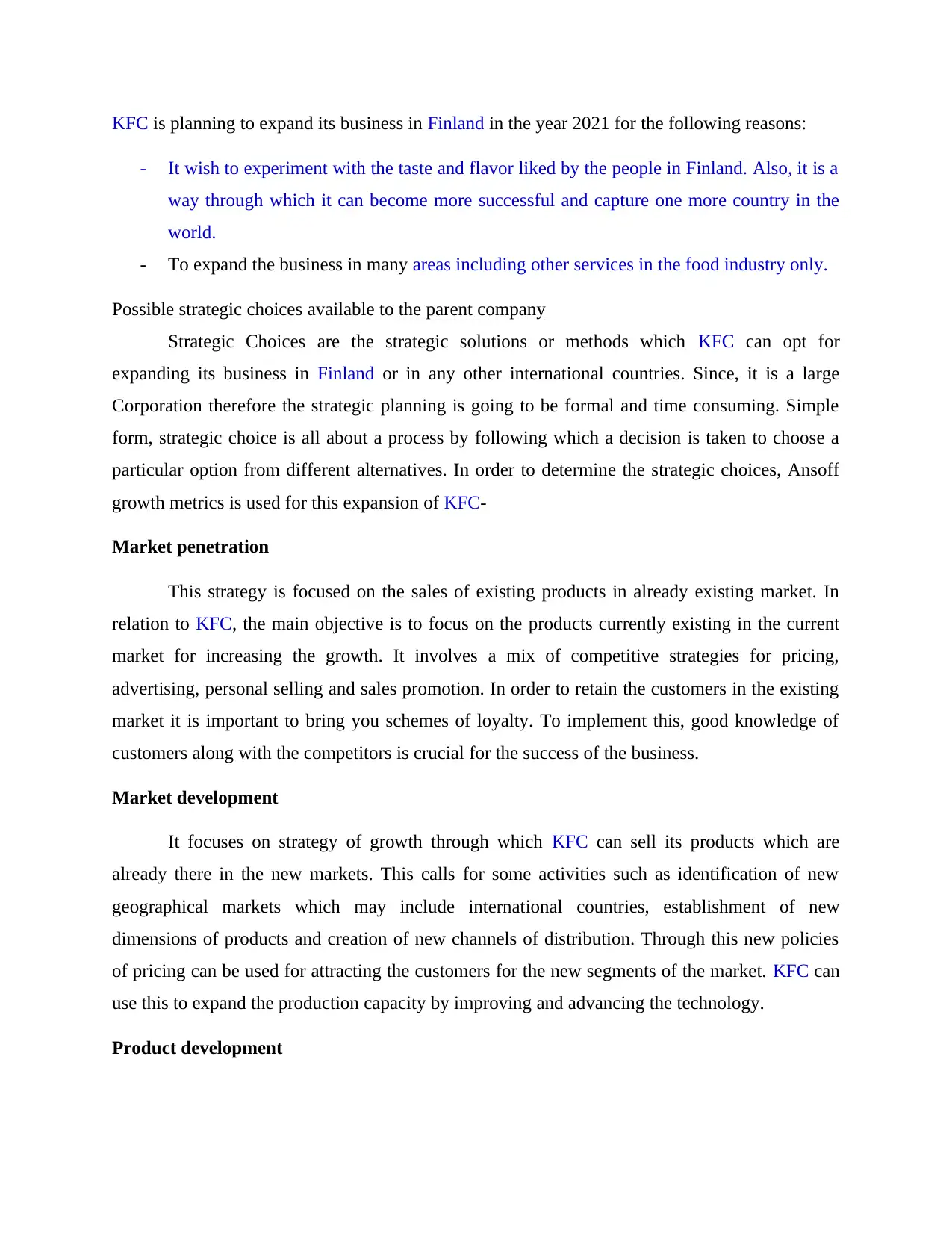
KFC is planning to expand its business in Finland in the year 2021 for the following reasons:
- It wish to experiment with the taste and flavor liked by the people in Finland. Also, it is a
way through which it can become more successful and capture one more country in the
world.
- To expand the business in many areas including other services in the food industry only.
Possible strategic choices available to the parent company
Strategic Choices are the strategic solutions or methods which KFC can opt for
expanding its business in Finland or in any other international countries. Since, it is a large
Corporation therefore the strategic planning is going to be formal and time consuming. Simple
form, strategic choice is all about a process by following which a decision is taken to choose a
particular option from different alternatives. In order to determine the strategic choices, Ansoff
growth metrics is used for this expansion of KFC-
Market penetration
This strategy is focused on the sales of existing products in already existing market. In
relation to KFC, the main objective is to focus on the products currently existing in the current
market for increasing the growth. It involves a mix of competitive strategies for pricing,
advertising, personal selling and sales promotion. In order to retain the customers in the existing
market it is important to bring you schemes of loyalty. To implement this, good knowledge of
customers along with the competitors is crucial for the success of the business.
Market development
It focuses on strategy of growth through which KFC can sell its products which are
already there in the new markets. This calls for some activities such as identification of new
geographical markets which may include international countries, establishment of new
dimensions of products and creation of new channels of distribution. Through this new policies
of pricing can be used for attracting the customers for the new segments of the market. KFC can
use this to expand the production capacity by improving and advancing the technology.
Product development
- It wish to experiment with the taste and flavor liked by the people in Finland. Also, it is a
way through which it can become more successful and capture one more country in the
world.
- To expand the business in many areas including other services in the food industry only.
Possible strategic choices available to the parent company
Strategic Choices are the strategic solutions or methods which KFC can opt for
expanding its business in Finland or in any other international countries. Since, it is a large
Corporation therefore the strategic planning is going to be formal and time consuming. Simple
form, strategic choice is all about a process by following which a decision is taken to choose a
particular option from different alternatives. In order to determine the strategic choices, Ansoff
growth metrics is used for this expansion of KFC-
Market penetration
This strategy is focused on the sales of existing products in already existing market. In
relation to KFC, the main objective is to focus on the products currently existing in the current
market for increasing the growth. It involves a mix of competitive strategies for pricing,
advertising, personal selling and sales promotion. In order to retain the customers in the existing
market it is important to bring you schemes of loyalty. To implement this, good knowledge of
customers along with the competitors is crucial for the success of the business.
Market development
It focuses on strategy of growth through which KFC can sell its products which are
already there in the new markets. This calls for some activities such as identification of new
geographical markets which may include international countries, establishment of new
dimensions of products and creation of new channels of distribution. Through this new policies
of pricing can be used for attracting the customers for the new segments of the market. KFC can
use this to expand the production capacity by improving and advancing the technology.
Product development
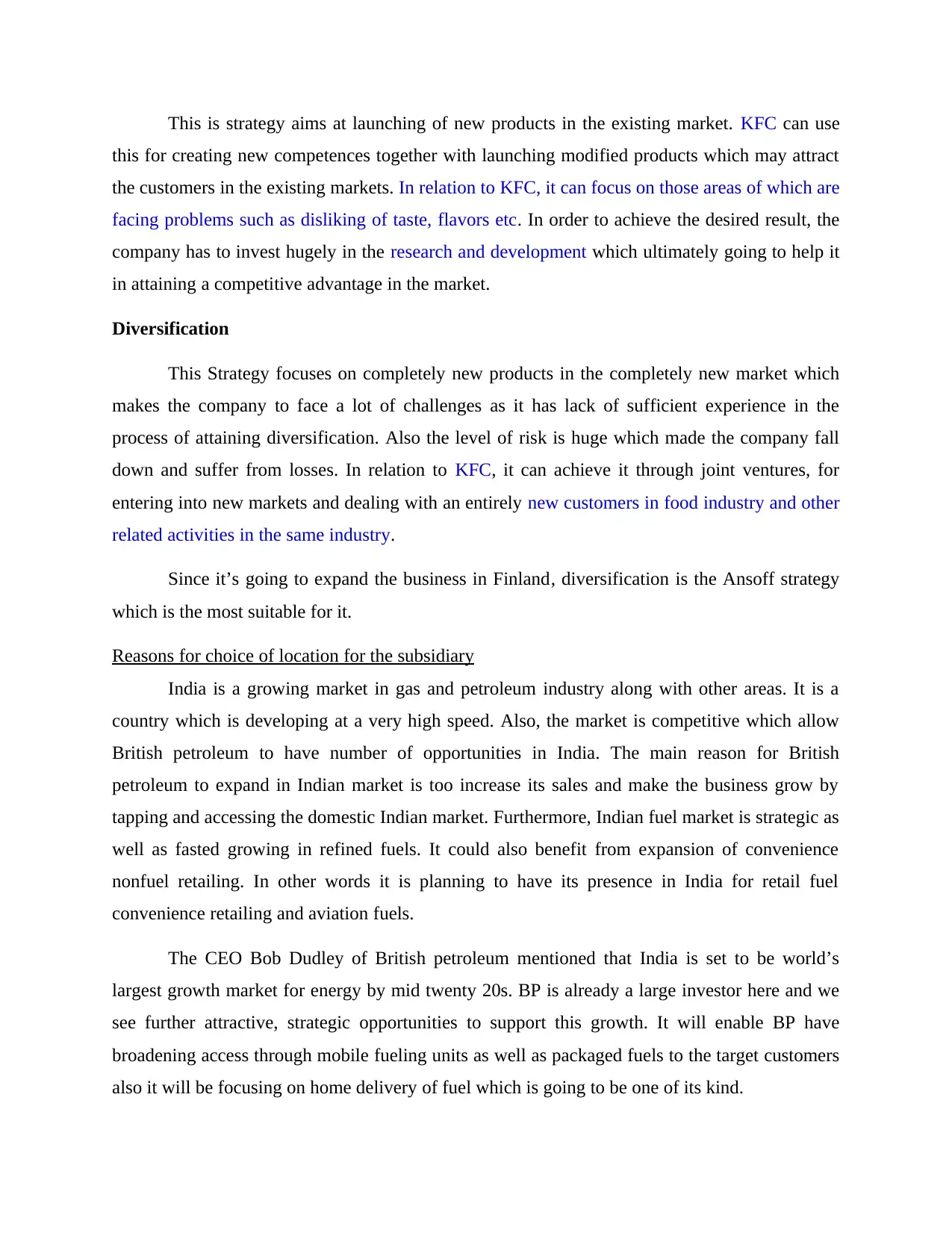
This is strategy aims at launching of new products in the existing market. KFC can use
this for creating new competences together with launching modified products which may attract
the customers in the existing markets. In relation to KFC, it can focus on those areas of which are
facing problems such as disliking of taste, flavors etc. In order to achieve the desired result, the
company has to invest hugely in the research and development which ultimately going to help it
in attaining a competitive advantage in the market.
Diversification
This Strategy focuses on completely new products in the completely new market which
makes the company to face a lot of challenges as it has lack of sufficient experience in the
process of attaining diversification. Also the level of risk is huge which made the company fall
down and suffer from losses. In relation to KFC, it can achieve it through joint ventures, for
entering into new markets and dealing with an entirely new customers in food industry and other
related activities in the same industry.
Since it’s going to expand the business in Finland, diversification is the Ansoff strategy
which is the most suitable for it.
Reasons for choice of location for the subsidiary
India is a growing market in gas and petroleum industry along with other areas. It is a
country which is developing at a very high speed. Also, the market is competitive which allow
British petroleum to have number of opportunities in India. The main reason for British
petroleum to expand in Indian market is too increase its sales and make the business grow by
tapping and accessing the domestic Indian market. Furthermore, Indian fuel market is strategic as
well as fasted growing in refined fuels. It could also benefit from expansion of convenience
nonfuel retailing. In other words it is planning to have its presence in India for retail fuel
convenience retailing and aviation fuels.
The CEO Bob Dudley of British petroleum mentioned that India is set to be world’s
largest growth market for energy by mid twenty 20s. BP is already a large investor here and we
see further attractive, strategic opportunities to support this growth. It will enable BP have
broadening access through mobile fueling units as well as packaged fuels to the target customers
also it will be focusing on home delivery of fuel which is going to be one of its kind.
this for creating new competences together with launching modified products which may attract
the customers in the existing markets. In relation to KFC, it can focus on those areas of which are
facing problems such as disliking of taste, flavors etc. In order to achieve the desired result, the
company has to invest hugely in the research and development which ultimately going to help it
in attaining a competitive advantage in the market.
Diversification
This Strategy focuses on completely new products in the completely new market which
makes the company to face a lot of challenges as it has lack of sufficient experience in the
process of attaining diversification. Also the level of risk is huge which made the company fall
down and suffer from losses. In relation to KFC, it can achieve it through joint ventures, for
entering into new markets and dealing with an entirely new customers in food industry and other
related activities in the same industry.
Since it’s going to expand the business in Finland, diversification is the Ansoff strategy
which is the most suitable for it.
Reasons for choice of location for the subsidiary
India is a growing market in gas and petroleum industry along with other areas. It is a
country which is developing at a very high speed. Also, the market is competitive which allow
British petroleum to have number of opportunities in India. The main reason for British
petroleum to expand in Indian market is too increase its sales and make the business grow by
tapping and accessing the domestic Indian market. Furthermore, Indian fuel market is strategic as
well as fasted growing in refined fuels. It could also benefit from expansion of convenience
nonfuel retailing. In other words it is planning to have its presence in India for retail fuel
convenience retailing and aviation fuels.
The CEO Bob Dudley of British petroleum mentioned that India is set to be world’s
largest growth market for energy by mid twenty 20s. BP is already a large investor here and we
see further attractive, strategic opportunities to support this growth. It will enable BP have
broadening access through mobile fueling units as well as packaged fuels to the target customers
also it will be focusing on home delivery of fuel which is going to be one of its kind.
⊘ This is a preview!⊘
Do you want full access?
Subscribe today to unlock all pages.

Trusted by 1+ million students worldwide
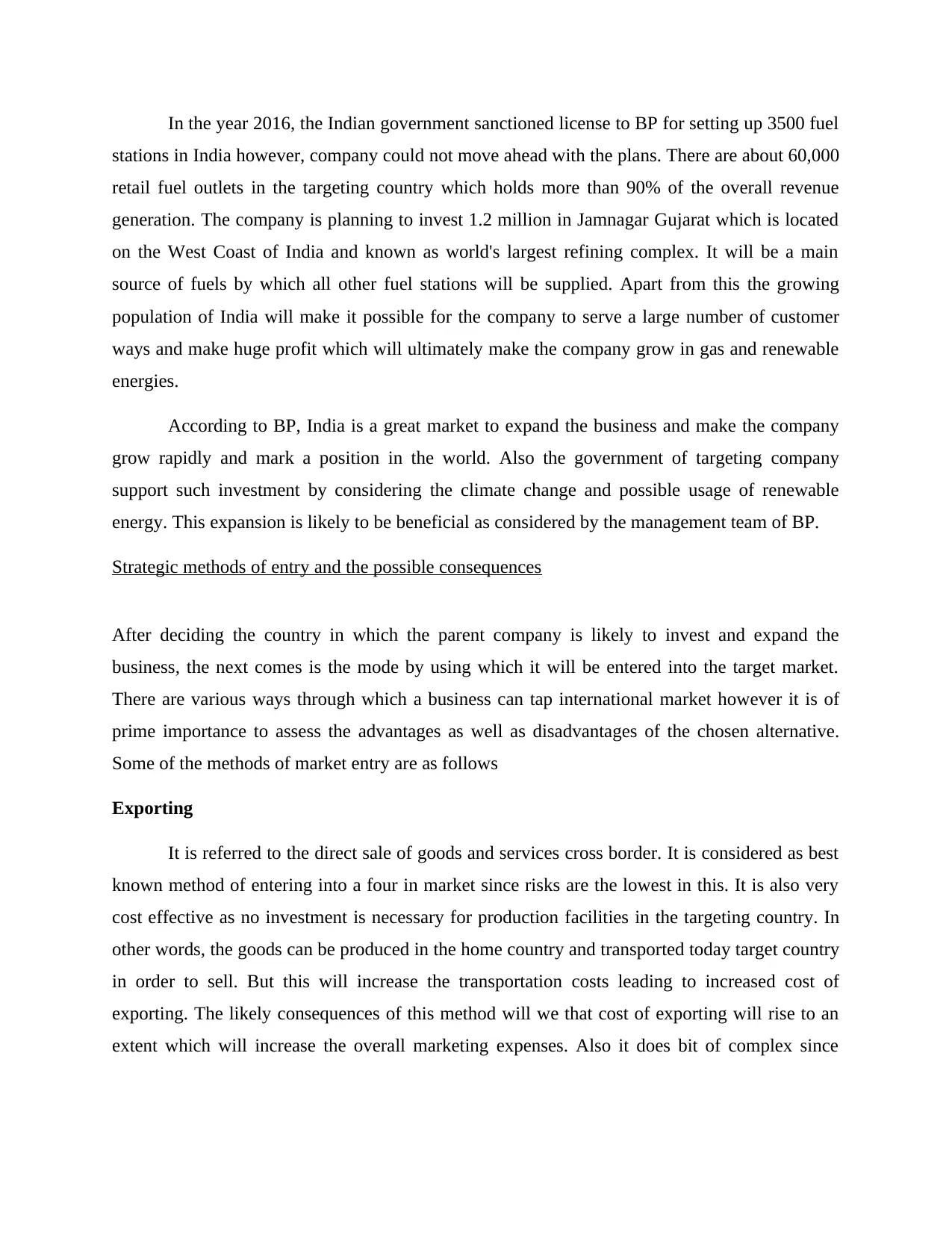
In the year 2016, the Indian government sanctioned license to BP for setting up 3500 fuel
stations in India however, company could not move ahead with the plans. There are about 60,000
retail fuel outlets in the targeting country which holds more than 90% of the overall revenue
generation. The company is planning to invest 1.2 million in Jamnagar Gujarat which is located
on the West Coast of India and known as world's largest refining complex. It will be a main
source of fuels by which all other fuel stations will be supplied. Apart from this the growing
population of India will make it possible for the company to serve a large number of customer
ways and make huge profit which will ultimately make the company grow in gas and renewable
energies.
According to BP, India is a great market to expand the business and make the company
grow rapidly and mark a position in the world. Also the government of targeting company
support such investment by considering the climate change and possible usage of renewable
energy. This expansion is likely to be beneficial as considered by the management team of BP.
Strategic methods of entry and the possible consequences
After deciding the country in which the parent company is likely to invest and expand the
business, the next comes is the mode by using which it will be entered into the target market.
There are various ways through which a business can tap international market however it is of
prime importance to assess the advantages as well as disadvantages of the chosen alternative.
Some of the methods of market entry are as follows
Exporting
It is referred to the direct sale of goods and services cross border. It is considered as best
known method of entering into a four in market since risks are the lowest in this. It is also very
cost effective as no investment is necessary for production facilities in the targeting country. In
other words, the goods can be produced in the home country and transported today target country
in order to sell. But this will increase the transportation costs leading to increased cost of
exporting. The likely consequences of this method will we that cost of exporting will rise to an
extent which will increase the overall marketing expenses. Also it does bit of complex since
stations in India however, company could not move ahead with the plans. There are about 60,000
retail fuel outlets in the targeting country which holds more than 90% of the overall revenue
generation. The company is planning to invest 1.2 million in Jamnagar Gujarat which is located
on the West Coast of India and known as world's largest refining complex. It will be a main
source of fuels by which all other fuel stations will be supplied. Apart from this the growing
population of India will make it possible for the company to serve a large number of customer
ways and make huge profit which will ultimately make the company grow in gas and renewable
energies.
According to BP, India is a great market to expand the business and make the company
grow rapidly and mark a position in the world. Also the government of targeting company
support such investment by considering the climate change and possible usage of renewable
energy. This expansion is likely to be beneficial as considered by the management team of BP.
Strategic methods of entry and the possible consequences
After deciding the country in which the parent company is likely to invest and expand the
business, the next comes is the mode by using which it will be entered into the target market.
There are various ways through which a business can tap international market however it is of
prime importance to assess the advantages as well as disadvantages of the chosen alternative.
Some of the methods of market entry are as follows
Exporting
It is referred to the direct sale of goods and services cross border. It is considered as best
known method of entering into a four in market since risks are the lowest in this. It is also very
cost effective as no investment is necessary for production facilities in the targeting country. In
other words, the goods can be produced in the home country and transported today target country
in order to sell. But this will increase the transportation costs leading to increased cost of
exporting. The likely consequences of this method will we that cost of exporting will rise to an
extent which will increase the overall marketing expenses. Also it does bit of complex since
Paraphrase This Document
Need a fresh take? Get an instant paraphrase of this document with our AI Paraphraser
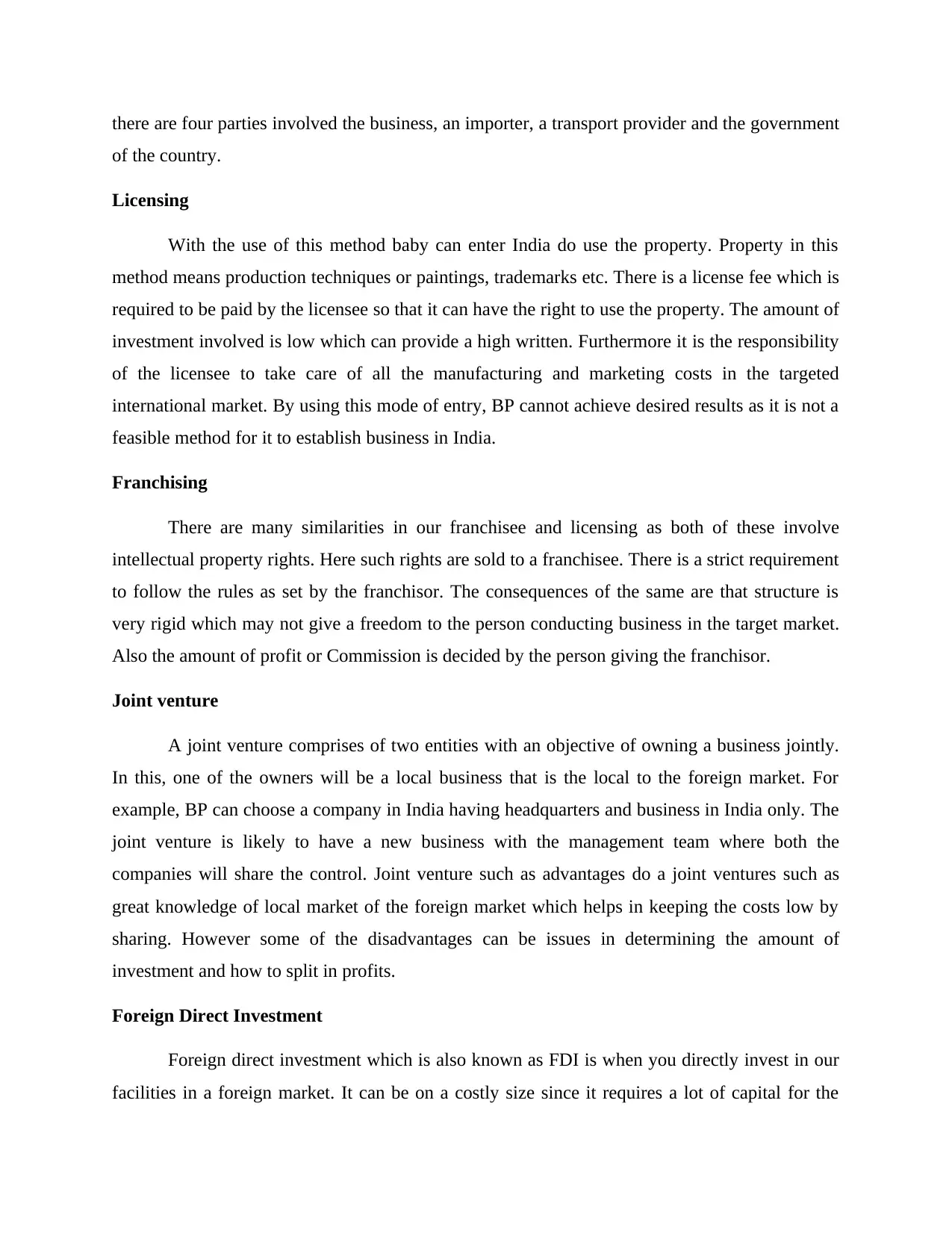
there are four parties involved the business, an importer, a transport provider and the government
of the country.
Licensing
With the use of this method baby can enter India do use the property. Property in this
method means production techniques or paintings, trademarks etc. There is a license fee which is
required to be paid by the licensee so that it can have the right to use the property. The amount of
investment involved is low which can provide a high written. Furthermore it is the responsibility
of the licensee to take care of all the manufacturing and marketing costs in the targeted
international market. By using this mode of entry, BP cannot achieve desired results as it is not a
feasible method for it to establish business in India.
Franchising
There are many similarities in our franchisee and licensing as both of these involve
intellectual property rights. Here such rights are sold to a franchisee. There is a strict requirement
to follow the rules as set by the franchisor. The consequences of the same are that structure is
very rigid which may not give a freedom to the person conducting business in the target market.
Also the amount of profit or Commission is decided by the person giving the franchisor.
Joint venture
A joint venture comprises of two entities with an objective of owning a business jointly.
In this, one of the owners will be a local business that is the local to the foreign market. For
example, BP can choose a company in India having headquarters and business in India only. The
joint venture is likely to have a new business with the management team where both the
companies will share the control. Joint venture such as advantages do a joint ventures such as
great knowledge of local market of the foreign market which helps in keeping the costs low by
sharing. However some of the disadvantages can be issues in determining the amount of
investment and how to split in profits.
Foreign Direct Investment
Foreign direct investment which is also known as FDI is when you directly invest in our
facilities in a foreign market. It can be on a costly size since it requires a lot of capital for the
of the country.
Licensing
With the use of this method baby can enter India do use the property. Property in this
method means production techniques or paintings, trademarks etc. There is a license fee which is
required to be paid by the licensee so that it can have the right to use the property. The amount of
investment involved is low which can provide a high written. Furthermore it is the responsibility
of the licensee to take care of all the manufacturing and marketing costs in the targeted
international market. By using this mode of entry, BP cannot achieve desired results as it is not a
feasible method for it to establish business in India.
Franchising
There are many similarities in our franchisee and licensing as both of these involve
intellectual property rights. Here such rights are sold to a franchisee. There is a strict requirement
to follow the rules as set by the franchisor. The consequences of the same are that structure is
very rigid which may not give a freedom to the person conducting business in the target market.
Also the amount of profit or Commission is decided by the person giving the franchisor.
Joint venture
A joint venture comprises of two entities with an objective of owning a business jointly.
In this, one of the owners will be a local business that is the local to the foreign market. For
example, BP can choose a company in India having headquarters and business in India only. The
joint venture is likely to have a new business with the management team where both the
companies will share the control. Joint venture such as advantages do a joint ventures such as
great knowledge of local market of the foreign market which helps in keeping the costs low by
sharing. However some of the disadvantages can be issues in determining the amount of
investment and how to split in profits.
Foreign Direct Investment
Foreign direct investment which is also known as FDI is when you directly invest in our
facilities in a foreign market. It can be on a costly size since it requires a lot of capital for the
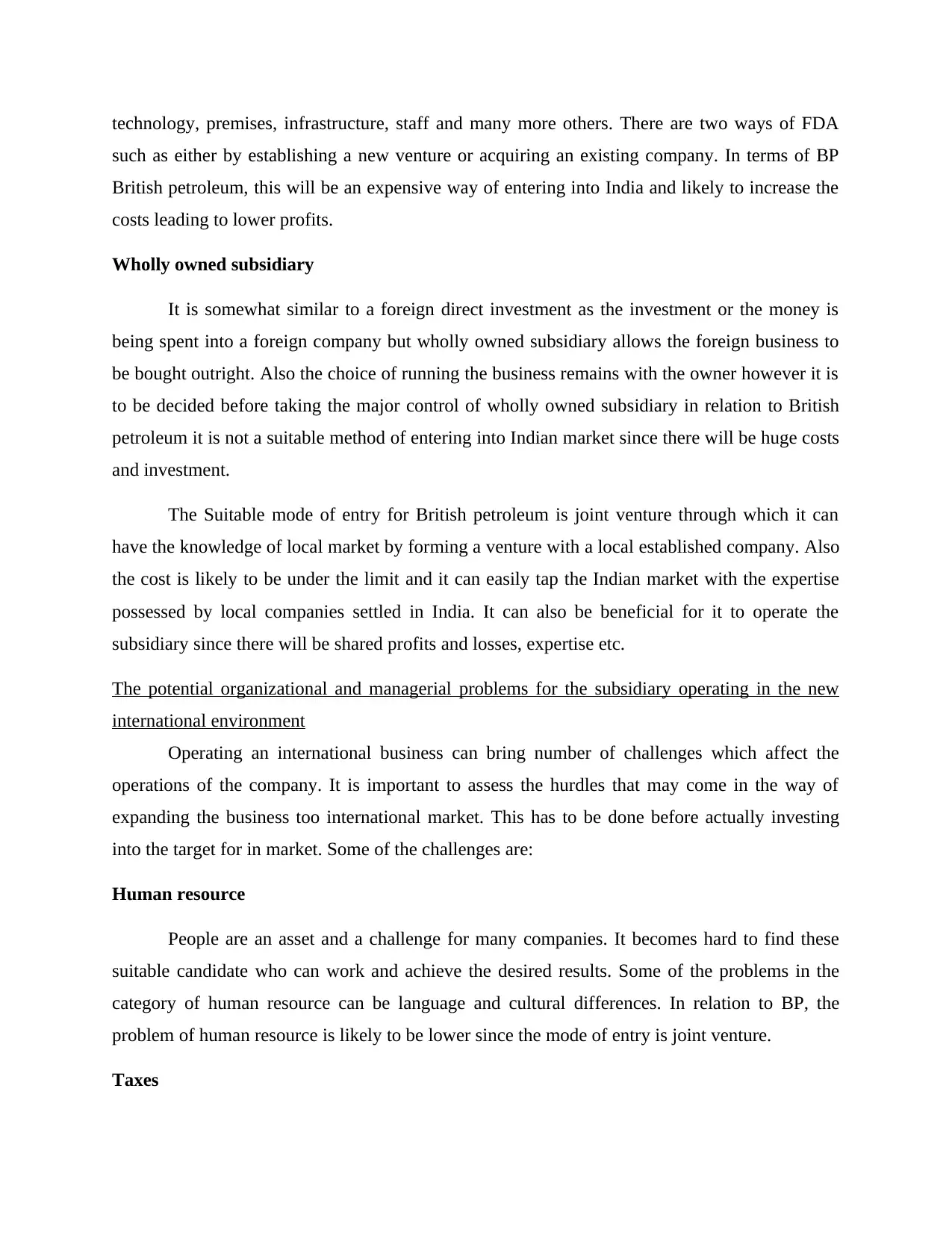
technology, premises, infrastructure, staff and many more others. There are two ways of FDA
such as either by establishing a new venture or acquiring an existing company. In terms of BP
British petroleum, this will be an expensive way of entering into India and likely to increase the
costs leading to lower profits.
Wholly owned subsidiary
It is somewhat similar to a foreign direct investment as the investment or the money is
being spent into a foreign company but wholly owned subsidiary allows the foreign business to
be bought outright. Also the choice of running the business remains with the owner however it is
to be decided before taking the major control of wholly owned subsidiary in relation to British
petroleum it is not a suitable method of entering into Indian market since there will be huge costs
and investment.
The Suitable mode of entry for British petroleum is joint venture through which it can
have the knowledge of local market by forming a venture with a local established company. Also
the cost is likely to be under the limit and it can easily tap the Indian market with the expertise
possessed by local companies settled in India. It can also be beneficial for it to operate the
subsidiary since there will be shared profits and losses, expertise etc.
The potential organizational and managerial problems for the subsidiary operating in the new
international environment
Operating an international business can bring number of challenges which affect the
operations of the company. It is important to assess the hurdles that may come in the way of
expanding the business too international market. This has to be done before actually investing
into the target for in market. Some of the challenges are:
Human resource
People are an asset and a challenge for many companies. It becomes hard to find these
suitable candidate who can work and achieve the desired results. Some of the problems in the
category of human resource can be language and cultural differences. In relation to BP, the
problem of human resource is likely to be lower since the mode of entry is joint venture.
Taxes
such as either by establishing a new venture or acquiring an existing company. In terms of BP
British petroleum, this will be an expensive way of entering into India and likely to increase the
costs leading to lower profits.
Wholly owned subsidiary
It is somewhat similar to a foreign direct investment as the investment or the money is
being spent into a foreign company but wholly owned subsidiary allows the foreign business to
be bought outright. Also the choice of running the business remains with the owner however it is
to be decided before taking the major control of wholly owned subsidiary in relation to British
petroleum it is not a suitable method of entering into Indian market since there will be huge costs
and investment.
The Suitable mode of entry for British petroleum is joint venture through which it can
have the knowledge of local market by forming a venture with a local established company. Also
the cost is likely to be under the limit and it can easily tap the Indian market with the expertise
possessed by local companies settled in India. It can also be beneficial for it to operate the
subsidiary since there will be shared profits and losses, expertise etc.
The potential organizational and managerial problems for the subsidiary operating in the new
international environment
Operating an international business can bring number of challenges which affect the
operations of the company. It is important to assess the hurdles that may come in the way of
expanding the business too international market. This has to be done before actually investing
into the target for in market. Some of the challenges are:
Human resource
People are an asset and a challenge for many companies. It becomes hard to find these
suitable candidate who can work and achieve the desired results. Some of the problems in the
category of human resource can be language and cultural differences. In relation to BP, the
problem of human resource is likely to be lower since the mode of entry is joint venture.
Taxes
⊘ This is a preview!⊘
Do you want full access?
Subscribe today to unlock all pages.

Trusted by 1+ million students worldwide
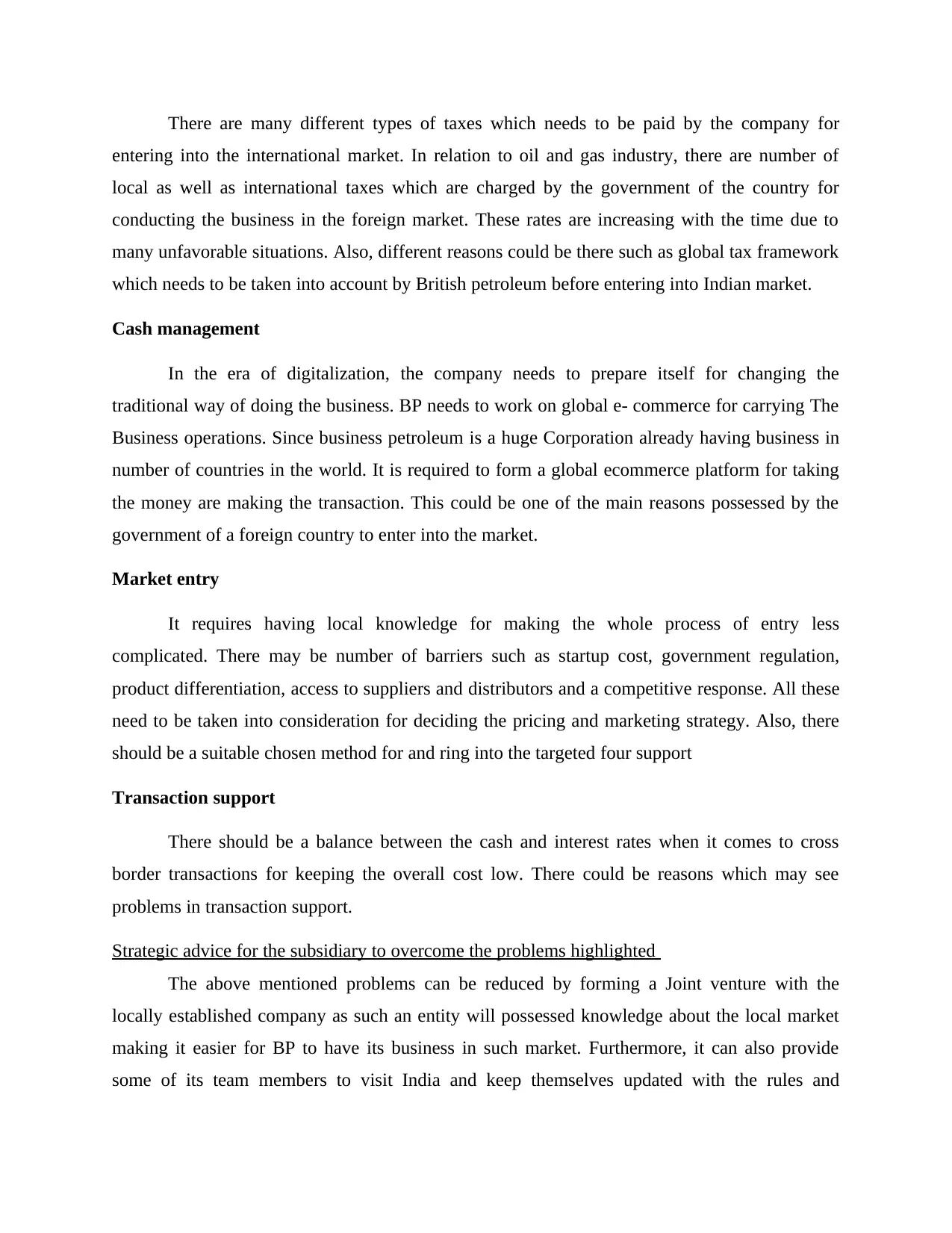
There are many different types of taxes which needs to be paid by the company for
entering into the international market. In relation to oil and gas industry, there are number of
local as well as international taxes which are charged by the government of the country for
conducting the business in the foreign market. These rates are increasing with the time due to
many unfavorable situations. Also, different reasons could be there such as global tax framework
which needs to be taken into account by British petroleum before entering into Indian market.
Cash management
In the era of digitalization, the company needs to prepare itself for changing the
traditional way of doing the business. BP needs to work on global e- commerce for carrying The
Business operations. Since business petroleum is a huge Corporation already having business in
number of countries in the world. It is required to form a global ecommerce platform for taking
the money are making the transaction. This could be one of the main reasons possessed by the
government of a foreign country to enter into the market.
Market entry
It requires having local knowledge for making the whole process of entry less
complicated. There may be number of barriers such as startup cost, government regulation,
product differentiation, access to suppliers and distributors and a competitive response. All these
need to be taken into consideration for deciding the pricing and marketing strategy. Also, there
should be a suitable chosen method for and ring into the targeted four support
Transaction support
There should be a balance between the cash and interest rates when it comes to cross
border transactions for keeping the overall cost low. There could be reasons which may see
problems in transaction support.
Strategic advice for the subsidiary to overcome the problems highlighted
The above mentioned problems can be reduced by forming a Joint venture with the
locally established company as such an entity will possessed knowledge about the local market
making it easier for BP to have its business in such market. Furthermore, it can also provide
some of its team members to visit India and keep themselves updated with the rules and
entering into the international market. In relation to oil and gas industry, there are number of
local as well as international taxes which are charged by the government of the country for
conducting the business in the foreign market. These rates are increasing with the time due to
many unfavorable situations. Also, different reasons could be there such as global tax framework
which needs to be taken into account by British petroleum before entering into Indian market.
Cash management
In the era of digitalization, the company needs to prepare itself for changing the
traditional way of doing the business. BP needs to work on global e- commerce for carrying The
Business operations. Since business petroleum is a huge Corporation already having business in
number of countries in the world. It is required to form a global ecommerce platform for taking
the money are making the transaction. This could be one of the main reasons possessed by the
government of a foreign country to enter into the market.
Market entry
It requires having local knowledge for making the whole process of entry less
complicated. There may be number of barriers such as startup cost, government regulation,
product differentiation, access to suppliers and distributors and a competitive response. All these
need to be taken into consideration for deciding the pricing and marketing strategy. Also, there
should be a suitable chosen method for and ring into the targeted four support
Transaction support
There should be a balance between the cash and interest rates when it comes to cross
border transactions for keeping the overall cost low. There could be reasons which may see
problems in transaction support.
Strategic advice for the subsidiary to overcome the problems highlighted
The above mentioned problems can be reduced by forming a Joint venture with the
locally established company as such an entity will possessed knowledge about the local market
making it easier for BP to have its business in such market. Furthermore, it can also provide
some of its team members to visit India and keep themselves updated with the rules and
Paraphrase This Document
Need a fresh take? Get an instant paraphrase of this document with our AI Paraphraser
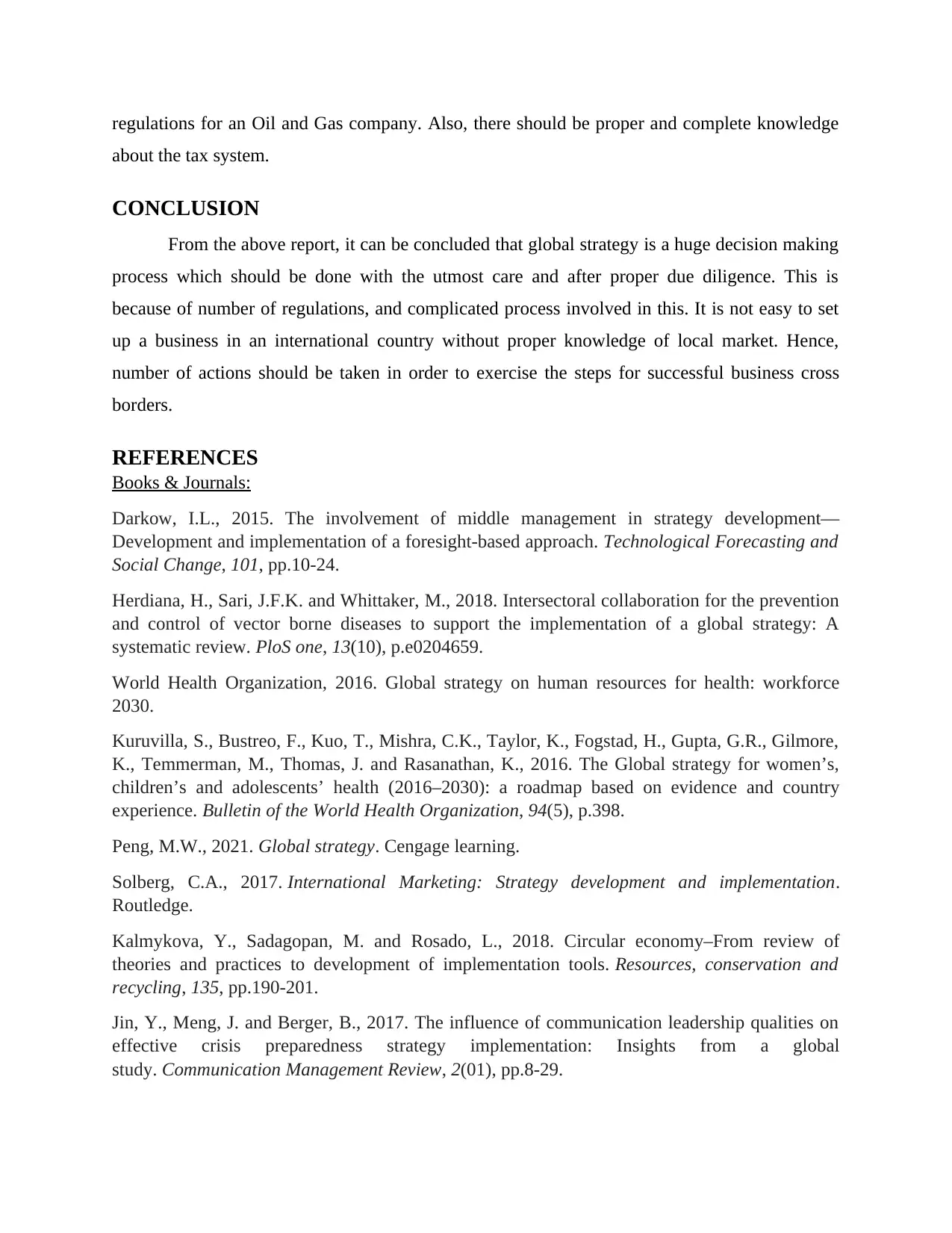
regulations for an Oil and Gas company. Also, there should be proper and complete knowledge
about the tax system.
CONCLUSION
From the above report, it can be concluded that global strategy is a huge decision making
process which should be done with the utmost care and after proper due diligence. This is
because of number of regulations, and complicated process involved in this. It is not easy to set
up a business in an international country without proper knowledge of local market. Hence,
number of actions should be taken in order to exercise the steps for successful business cross
borders.
REFERENCES
Books & Journals:
Darkow, I.L., 2015. The involvement of middle management in strategy development—
Development and implementation of a foresight-based approach. Technological Forecasting and
Social Change, 101, pp.10-24.
Herdiana, H., Sari, J.F.K. and Whittaker, M., 2018. Intersectoral collaboration for the prevention
and control of vector borne diseases to support the implementation of a global strategy: A
systematic review. PloS one, 13(10), p.e0204659.
World Health Organization, 2016. Global strategy on human resources for health: workforce
2030.
Kuruvilla, S., Bustreo, F., Kuo, T., Mishra, C.K., Taylor, K., Fogstad, H., Gupta, G.R., Gilmore,
K., Temmerman, M., Thomas, J. and Rasanathan, K., 2016. The Global strategy for women’s,
children’s and adolescents’ health (2016–2030): a roadmap based on evidence and country
experience. Bulletin of the World Health Organization, 94(5), p.398.
Peng, M.W., 2021. Global strategy. Cengage learning.
Solberg, C.A., 2017. International Marketing: Strategy development and implementation.
Routledge.
Kalmykova, Y., Sadagopan, M. and Rosado, L., 2018. Circular economy–From review of
theories and practices to development of implementation tools. Resources, conservation and
recycling, 135, pp.190-201.
Jin, Y., Meng, J. and Berger, B., 2017. The influence of communication leadership qualities on
effective crisis preparedness strategy implementation: Insights from a global
study. Communication Management Review, 2(01), pp.8-29.
about the tax system.
CONCLUSION
From the above report, it can be concluded that global strategy is a huge decision making
process which should be done with the utmost care and after proper due diligence. This is
because of number of regulations, and complicated process involved in this. It is not easy to set
up a business in an international country without proper knowledge of local market. Hence,
number of actions should be taken in order to exercise the steps for successful business cross
borders.
REFERENCES
Books & Journals:
Darkow, I.L., 2015. The involvement of middle management in strategy development—
Development and implementation of a foresight-based approach. Technological Forecasting and
Social Change, 101, pp.10-24.
Herdiana, H., Sari, J.F.K. and Whittaker, M., 2018. Intersectoral collaboration for the prevention
and control of vector borne diseases to support the implementation of a global strategy: A
systematic review. PloS one, 13(10), p.e0204659.
World Health Organization, 2016. Global strategy on human resources for health: workforce
2030.
Kuruvilla, S., Bustreo, F., Kuo, T., Mishra, C.K., Taylor, K., Fogstad, H., Gupta, G.R., Gilmore,
K., Temmerman, M., Thomas, J. and Rasanathan, K., 2016. The Global strategy for women’s,
children’s and adolescents’ health (2016–2030): a roadmap based on evidence and country
experience. Bulletin of the World Health Organization, 94(5), p.398.
Peng, M.W., 2021. Global strategy. Cengage learning.
Solberg, C.A., 2017. International Marketing: Strategy development and implementation.
Routledge.
Kalmykova, Y., Sadagopan, M. and Rosado, L., 2018. Circular economy–From review of
theories and practices to development of implementation tools. Resources, conservation and
recycling, 135, pp.190-201.
Jin, Y., Meng, J. and Berger, B., 2017. The influence of communication leadership qualities on
effective crisis preparedness strategy implementation: Insights from a global
study. Communication Management Review, 2(01), pp.8-29.
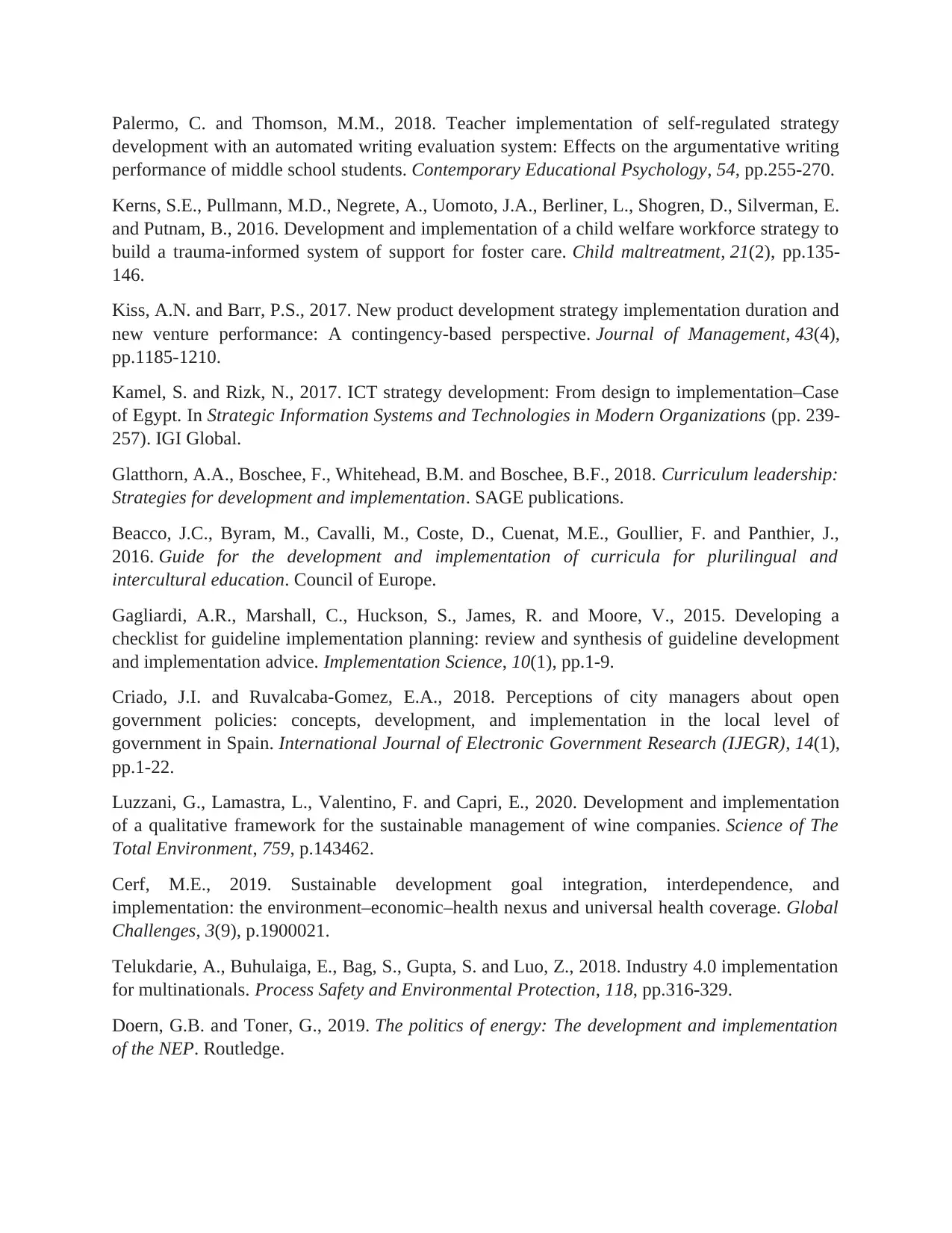
Palermo, C. and Thomson, M.M., 2018. Teacher implementation of self-regulated strategy
development with an automated writing evaluation system: Effects on the argumentative writing
performance of middle school students. Contemporary Educational Psychology, 54, pp.255-270.
Kerns, S.E., Pullmann, M.D., Negrete, A., Uomoto, J.A., Berliner, L., Shogren, D., Silverman, E.
and Putnam, B., 2016. Development and implementation of a child welfare workforce strategy to
build a trauma-informed system of support for foster care. Child maltreatment, 21(2), pp.135-
146.
Kiss, A.N. and Barr, P.S., 2017. New product development strategy implementation duration and
new venture performance: A contingency-based perspective. Journal of Management, 43(4),
pp.1185-1210.
Kamel, S. and Rizk, N., 2017. ICT strategy development: From design to implementation–Case
of Egypt. In Strategic Information Systems and Technologies in Modern Organizations (pp. 239-
257). IGI Global.
Glatthorn, A.A., Boschee, F., Whitehead, B.M. and Boschee, B.F., 2018. Curriculum leadership:
Strategies for development and implementation. SAGE publications.
Beacco, J.C., Byram, M., Cavalli, M., Coste, D., Cuenat, M.E., Goullier, F. and Panthier, J.,
2016. Guide for the development and implementation of curricula for plurilingual and
intercultural education. Council of Europe.
Gagliardi, A.R., Marshall, C., Huckson, S., James, R. and Moore, V., 2015. Developing a
checklist for guideline implementation planning: review and synthesis of guideline development
and implementation advice. Implementation Science, 10(1), pp.1-9.
Criado, J.I. and Ruvalcaba-Gomez, E.A., 2018. Perceptions of city managers about open
government policies: concepts, development, and implementation in the local level of
government in Spain. International Journal of Electronic Government Research (IJEGR), 14(1),
pp.1-22.
Luzzani, G., Lamastra, L., Valentino, F. and Capri, E., 2020. Development and implementation
of a qualitative framework for the sustainable management of wine companies. Science of The
Total Environment, 759, p.143462.
Cerf, M.E., 2019. Sustainable development goal integration, interdependence, and
implementation: the environment–economic–health nexus and universal health coverage. Global
Challenges, 3(9), p.1900021.
Telukdarie, A., Buhulaiga, E., Bag, S., Gupta, S. and Luo, Z., 2018. Industry 4.0 implementation
for multinationals. Process Safety and Environmental Protection, 118, pp.316-329.
Doern, G.B. and Toner, G., 2019. The politics of energy: The development and implementation
of the NEP. Routledge.
development with an automated writing evaluation system: Effects on the argumentative writing
performance of middle school students. Contemporary Educational Psychology, 54, pp.255-270.
Kerns, S.E., Pullmann, M.D., Negrete, A., Uomoto, J.A., Berliner, L., Shogren, D., Silverman, E.
and Putnam, B., 2016. Development and implementation of a child welfare workforce strategy to
build a trauma-informed system of support for foster care. Child maltreatment, 21(2), pp.135-
146.
Kiss, A.N. and Barr, P.S., 2017. New product development strategy implementation duration and
new venture performance: A contingency-based perspective. Journal of Management, 43(4),
pp.1185-1210.
Kamel, S. and Rizk, N., 2017. ICT strategy development: From design to implementation–Case
of Egypt. In Strategic Information Systems and Technologies in Modern Organizations (pp. 239-
257). IGI Global.
Glatthorn, A.A., Boschee, F., Whitehead, B.M. and Boschee, B.F., 2018. Curriculum leadership:
Strategies for development and implementation. SAGE publications.
Beacco, J.C., Byram, M., Cavalli, M., Coste, D., Cuenat, M.E., Goullier, F. and Panthier, J.,
2016. Guide for the development and implementation of curricula for plurilingual and
intercultural education. Council of Europe.
Gagliardi, A.R., Marshall, C., Huckson, S., James, R. and Moore, V., 2015. Developing a
checklist for guideline implementation planning: review and synthesis of guideline development
and implementation advice. Implementation Science, 10(1), pp.1-9.
Criado, J.I. and Ruvalcaba-Gomez, E.A., 2018. Perceptions of city managers about open
government policies: concepts, development, and implementation in the local level of
government in Spain. International Journal of Electronic Government Research (IJEGR), 14(1),
pp.1-22.
Luzzani, G., Lamastra, L., Valentino, F. and Capri, E., 2020. Development and implementation
of a qualitative framework for the sustainable management of wine companies. Science of The
Total Environment, 759, p.143462.
Cerf, M.E., 2019. Sustainable development goal integration, interdependence, and
implementation: the environment–economic–health nexus and universal health coverage. Global
Challenges, 3(9), p.1900021.
Telukdarie, A., Buhulaiga, E., Bag, S., Gupta, S. and Luo, Z., 2018. Industry 4.0 implementation
for multinationals. Process Safety and Environmental Protection, 118, pp.316-329.
Doern, G.B. and Toner, G., 2019. The politics of energy: The development and implementation
of the NEP. Routledge.
⊘ This is a preview!⊘
Do you want full access?
Subscribe today to unlock all pages.

Trusted by 1+ million students worldwide
1 out of 13
Related Documents
Your All-in-One AI-Powered Toolkit for Academic Success.
+13062052269
info@desklib.com
Available 24*7 on WhatsApp / Email
![[object Object]](/_next/static/media/star-bottom.7253800d.svg)
Unlock your academic potential
Copyright © 2020–2025 A2Z Services. All Rights Reserved. Developed and managed by ZUCOL.





